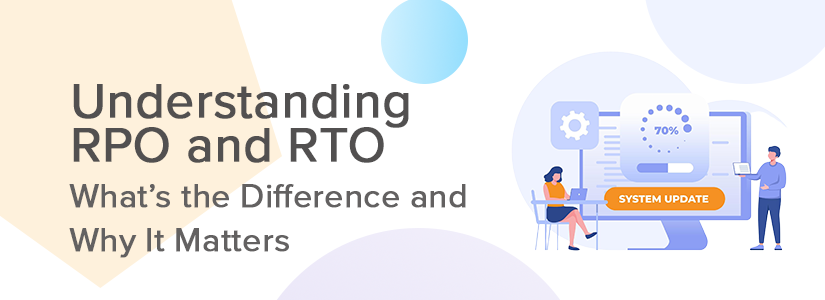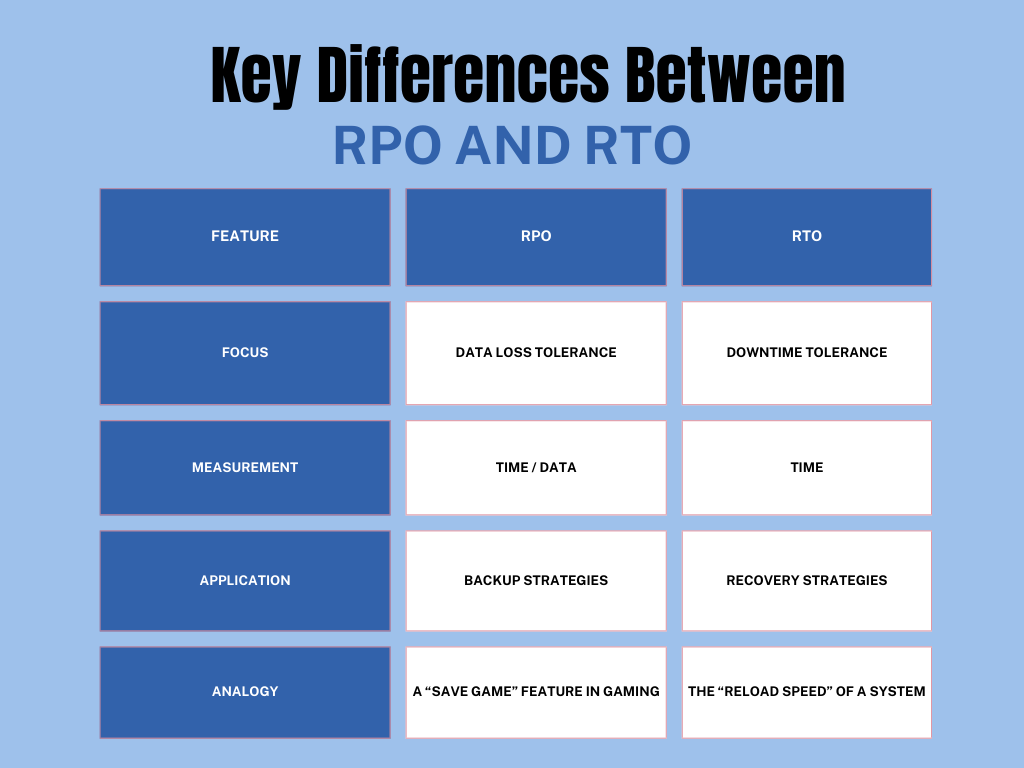Understanding RPO and RTO: What’s the Difference and Why It Matters for Your Business

In today’s fast-paced digital era, businesses are increasingly dependent on technology to drive their operations and maintain competitiveness. But when systems fail, the consequences can be severe. Downtime and data loss can cost businesses millions of dollars annually, with some organizations losing as much as $300,000 per hour during an outage. These disruptions harm finances, compromise a company’s reputation, and diminish customer trust.
How can businesses protect themselves from these risks? A well-structured disaster recovery plan is crucial, and at its heart are two important components: Recovery Point Objective (RPO) and Recovery Time Objective (RTO). RPO determines the maximum amount of data loss a business can tolerate in an incident, while RTO measures how quickly operations need to be restored. Together, they address different aspects of recovery while working to ensure business continuity.
In this article, we’ll explore RPO and RTO and their differences, providing real-world examples, and sharing practical tips to help you define and optimize these objectives for your business.
What is RPO (Recovery Point Objective)
RPO, or Recovery Point Objective, refers to the maximum acceptable amount of data loss measured in time. In simpler terms, it indicates how far back in time your data can be recovered from backups or replicas after an outage. This helps businesses define their tolerance for data loss, ensuring that recovery strategies align with operational needs. For instance, an RPO of one hour means that if a disruption occurs, your organization must restore data from no more than one hour ago, minimizing the impact on critical processes. Setting an appropriate RPO requires businesses to carefully evaluate their operations and identify the most critical data to maintain continuity.
Consider an online retail business that processes hundreds of transactions every hour. If this business sets its RPO to two hours, it means it can tolerate losing up to two hours’ worth of transaction data in the event of a failure. However, this tolerance level also assumes that the business has a backup system capable of restoring operations within this time frame. If data from beyond this two-hour window is lost, the financial and reputational damage could be substantial, emphasizing the importance of setting realistic RPO targets.
Factors Impacting RPO:
1. Data Criticality: Highly sensitive or valuable data, such as customer financial information, requires stricter RPOs.
2. Backup Frequency: The more frequently you back up data, the lower your RPO can be. Automated backups play a key role in minimizing RPO.
3. Storage Solutions: Leveraging modern storage technologies like cloud-based backups can significantly reduce RPO by ensuring real-time or near-real-time data replication.
What is RTO (Recovery Time Objective)
RTO, or Recovery Time Objective, defines the maximum time to restore operations after a disruption. Essentially, it’s the deadline for getting your systems back up and running to avoid unacceptable impacts on business operations. A well-defined RTO ensures that business recovery plans are effective and aligned with the organization’s capabilities. Without a clear RTO, recovery efforts may falter, leaving critical systems offline for longer than manageable, which could severely impact revenue and customer trust.
To understand the importance of RTO, consider how it directly impacts an organization’s ability to resume operations quickly after a disruption. For instance, if there is an e-commerce platform during a Black Friday sale, an RTO of two hours might be acceptable on a normal day but could be disastrous during peak sales periods, where every minute of downtime equates to thousands of dollars in lost revenue. During such high-stakes events, businesses may need to invest in advanced failover systems or high-availability solutions to meet a tighter RTO. Failing to do so not only results in lost sales but can also damage the brand’s reputation and customer loyalty, especially during periods when customer expectations are at their highest.
Factors Impacting RTO:
1. Business Operations Dependency: Critical systems with a direct impact on revenue or customer satisfaction require faster RTOs.
2. System Complexity: Complex infrastructures with interdependent components often take longer to restore.
3. Recovery Infrastructure: High-availability systems, such as failover clusters and redundant networks, help reduce RTO by enabling faster recovery.
Key Differences Between RPO and RTO
To better understand these two criteria, it’s helpful to compare them side by side:
Both RPO and RTO are crucial components in minimizing the impact of outages on your business. While RPO focuses on the amount of data loss an organization can tolerate, RTO is concerned with how quickly systems must be restored to avoid business disruption. Although they address different aspects of recovery, RPO and RTO work hand-in-hand to ensure business continuity. Understanding and defining both RPO and RTO is essential for organizations to build resilient systems that can weather unexpected events without compromising service or revenue.
Why RPO and RTO Matter for Your Business
Business Impact: The consequences of insufficient RPO and RTO can be severe
- Customer Trust: Prolonged downtime or data loss can damage a company’s reputation, resulting in customers losing confidence in a company’s ability to protect their information.
- Financial Losses: Downtime costs businesses an average of $5,600 per minute
- Legal and Compliance Implications: Industries such as healthcare and finance are subject to strict regulations. Failing to meet RPO and RTO requirements can result in hefty fines.
Industries:
- Healthcare: Hospitals rely on real-time patient data to provide critical care. An RPO of seconds and an RTO of minutes are often necessary to ensure patient safety.
- Finance: Banks and trading platforms handle high volumes of transactions that demand near-zero data loss and rapid recovery to maintain market integrity.
How to Define and Implement RPO and RTO
Step-by-Step Guide:
1. Identify Critical Systems and Data: Determine which systems and datasets are essential for your operations. Prioritize them based on their impact on revenue and customer satisfaction.
2. Assess Acceptable Downtime and Data Loss: Collaborate with stakeholders to establish thresholds for acceptable downtime and data loss.
3. Align RPO/RTO Goals with Disaster Recovery Strategies: Select technologies and processes that support your specific objectives. For instance, cloud-based solutions can offer lower RPOs and RTOs than traditional on-premises systems.
4. Test and Refine Plans Regularly: Conduct disaster recovery drills to ensure your RPO and RTO are achievable and adjust strategies as needed.
Tools and Solutions:
- Tools and services can streamline backup processes and reduce RPO as well as enable rapid system restoration to minimize RTO.
- Managed services: Intradyn offers comprehensive data archiving and disaster recovery solutions, helping businesses stay resilient.
Practical Tips for Optimizing RPO and RTO
Backup Best Practices:
- Regular and Automated Backups: Schedule frequent backups to reduce RPO. Consider using incremental backups to save time and storage space.
- Offsite/Cloud Storage: Store backups in secure offsite or cloud locations to protect against localized disasters.
Recovery Planning:
- Invest in High-Availability Systems: Implement surplus systems and failover mechanisms to minimize downtime.
- Conduct Regular Drills and Simulations: Test your disaster recovery plan in realistic scenarios to identify and address potential weaknesses.
Conclusion
RPO and RTO are lifelines for businesses aiming to navigate the complexities of disaster recovery. By understanding their differences and significance, you can create a resilient strategy that safeguards your operations, protects customer trust, and ensures compliance with industry regulations. Evaluate your current disaster recovery plans, refine your objectives, and leverage advanced tools and services to optimize your RPO and RTO. Preparation today prevents panic tomorrow.


